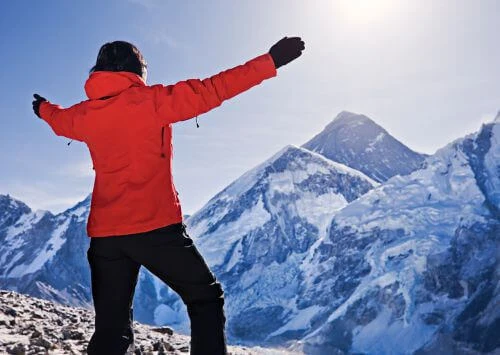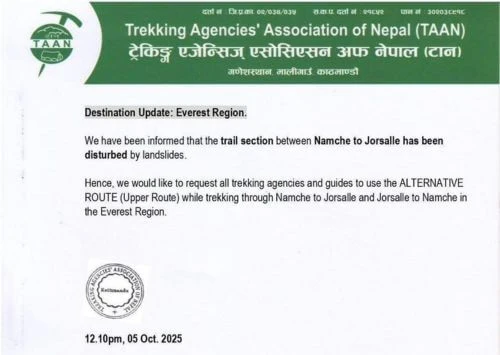Looking to climb Mera Peak? Here are the most essential do's and don'ts for a safe ascent. Read on and make sure you take all necessary precautions!
Mera Peak is a challenging but rewarding mountain to climb, and with careful preparation and good technique, any climber can reach the summit. Before you set out on your Mera Peak adventure, learn more about the necessary equipment, safety tips, and other essential tricks to ensure your ascent goes as smoothly as possible.
When climbing any peak, there are several things you should do and things you should avoid doing to ensure your safety and make the experience enjoyable. Here are some do's and don'ts for climbing peaks:
Things to do.
- Plan your climb, including the route, weather conditions, equipment needed, and emergency procedures.
- Get proper training and experience before attempting a peak climb.
- Bring adequate food, water, and clothing for the climb, and pack them properly.
- Use appropriate equipment, such as ropes, harnesses, helmets, and crampons, and ensure it is in good condition.
- Follow Leave No Trace principles to minimize your impact on the environment.
- Check-in with local authorities and tell someone where you are going and when you plan to return.
- Be aware of your surroundings and adjust your plan if necessary due to changing weather or other conditions.
- Take breaks as needed, and don't push yourself beyond your limits.
- Practice good hygiene and sanitation to prevent the spread of disease.
Things not to do.
- Don't underestimate the difficulty of the climb or overestimate your abilities.
- Don't ignore warning signs or advice from local authorities or experienced climbers.
- Don't climb alone, always have at least one partner and communicate regularly.
- Don't consume drugs or alcohol while climbing, as they can impair your judgment and coordination.
- Don't litter or leave trash behind on the trail or at the campsite.
- Don't climb during severe weather conditions like heavy rain or thunderstorms.
- Don't take unnecessary risks or shortcuts, even if it means abandoning your summit attempt.
- Don't disturb wildlife or their habitat while climbing.
- Don't climb outside designated climbing areas without the proper permits or permissions.
Let’s briefly discuss some of the topics.
Do research: Get to know the terrain, weather, and team composition.
Properly researching your attempt at Mera Peak is one of the most important steps on your journey. Familiarize yourself with the terrain and weather patterns so that you can prepare the best possible strategy for tackling the mountain. Additionally, it’s important to get to know those in your team—try to evaluate levels of experience and physical fitness before departing for your trip. Make sure everyone is adequately prepared for this challenge before setting off!
Don't underestimate the effects of altitude sickness.
Altitude sickness can affect anyone, regardless of experience and physical fitness. Understanding the signs and symptoms of altitude sickness is incredibly important to ensure the safety of your team within the upper elevations. Common signs of altitude sickness include nausea, headaches, sleeplessness, dizziness or fatigue. If you recognize any concerning changes in your own body or that of your team members, immediately descent to a lower elevation and seek medical advice.
Do stay hydrated by drinking plenty of water and eating enough food.
Being hydrated is one of the most important steps you can take when ascending Mera Peak. It's essential that you drink at least four to five liters per day of water, and have a nutritionally balanced diet to maintain a good energy level throughout your ascent. The air at higher altitudes has less oxygen so your body needs to be well-nourished and well-hydrated in order to fight off any altitude related sickness. Eating enough carbohydrates and proteins will also ensure that you have the necessary energy for acclimatizing in the upper elevations and making it to the summit.
Don't skip acclimatization days when ascending higher peaks.
Acclimatization is an important process, especially when you ascend Mera Peak. As we gain altitude, the amount of oxygen in the air decreases. To adjust properly to these changes and avoid altitude sickness, it’s important that climbers give their bodies time to acclimatize by ascending slowly over several days with periodic rest days along the way. This will ensure your body can get used to adjustments of lower oxygen levels and allow your body enough time to make red blood cells at high altitudes in order to cope with the lack of oxygen. Ascending too quickly without giving yourself proper acclimatization time could increase your risk of altitude sickness.
Plan for any possibilities and communicate them to your team before you leave the airport or hotel.
Planning ahead and creating a communication strategy before heading out on an expedition is always important. Map out how your team will contact each other during the climb, and make sure everyone is aware of the emergency procedures if anything should happen. Discuss accommodation and safety options in the area, and be aware of any known dangers such as wildlife, extreme weather or altitude sickness. Finally, remember to tell a responsible family member or friend your itinerary so that they know when to expect you back from your adventure.
Recommended Read: Complete Guide for Mera Peak Climbing





